What's new in YourTradebase?
Choose permissions for your admin team
31 August 2022
Want to give your admin members more – or less – control over what they can do in YourTradebase?
Then we’ve got a great little update to share with you today. Introducing… Admin permissions: the power to grant permissions to each admin on your team.
What permissions can we grant?
For starters, you get to choose whether your admins can export data, add other team members, create and view quotes and invoices. If we hear enough requests for other permissions then we’ll add those too, so let us know if you’d like to see something else to this list.
You’re able to choose extra permissions – or take permissions away – for admins when you add a new admin or edit an existing admin from Settings > Manage team. Just check the permissions you want to grant, and un-check those you want to take away.
Here’s how that looks:
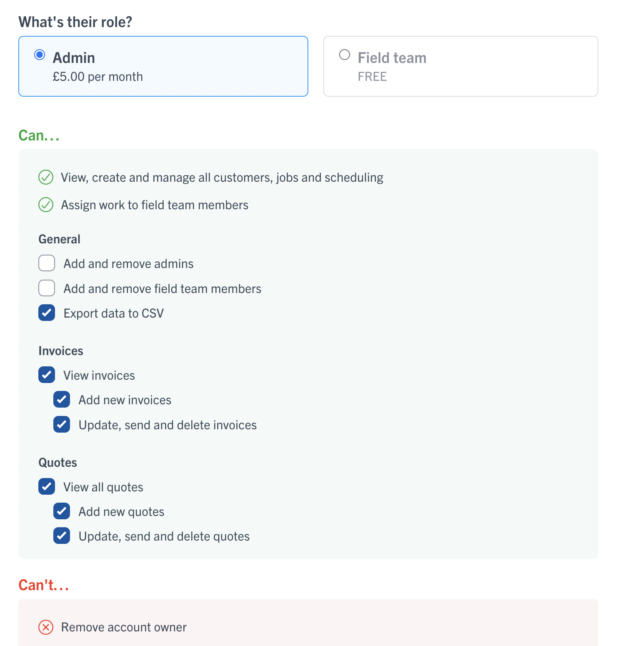
Permissions for your admin team are ready for you to set right now. Visit Settings > Manage team to get started.
👍
Connect to QuickBooks
29 July 2022
If you use QuickBooks to keep your accounting in order, then we’ve got great news for you – you can now connect YourTradebase to your QuickBooks account 🎉
Invoices and payments can now be sent automatically to QuickBooks account, and then kept in sync. That means your invoices, cashflow and bookkeeping are all connected, all kept in sync, and all sorted.
No more double data-entry for you!
Invoices and payments kept in-sync
Once you’ve connected your QuickBooks account, any invoice you create or payment you add will be sent over to QuickBooks automatically.

Get started with QuickBooks
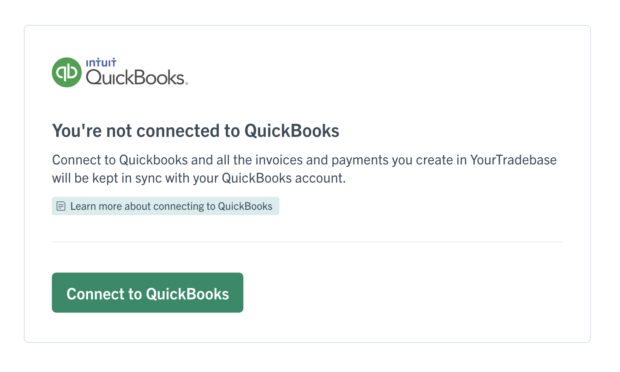
Get started today by visiting Settings > Connect to QuickBooks and you’ll be up and running in a few quick clicks.
Or get more help with how to connect to QuickBooks in our help guides.
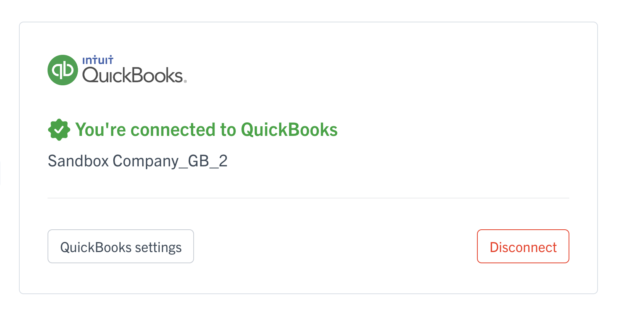
Happy syncing!
Introducing auto-messages
12 May 2022
Keeping in touch with customers and sending the right messages at the right time is vital to delivering fantastic service and growing your business. Forgetting to follow-up with a customer, or not chasing a late payment, can be costly.
So we’re delighted to introduce auto-messages: an easy – and automatic – way to make sure you always send the right message, to the right customer, at the right time.
Auto-messages lets you send customised, personalised messages to customers at exactly the right time… and we’ll make sure those messages get sent. Meaning you can spend less time on admin by automatically sending messages to follow-up, chase, and remind customers.
You might set up an auto-message…
- To follow-up quotes that haven’t been replied to
- To chase late payments
- To thank customers for accepting your quote
- To send an appointment confirmation
- … and more
It’s automatic and super-easy to set up.
Easily send messages… automatically
You choose which personalised email template to send and when it should be sent, and YourTradebase will take care of the rest.
Whether you want to automatically follow-up on quotes you’ve sent after 5 days, or chase payments the day they become due, setting up auto-messages is easy and takes just a few clicks.
- Choose a trigger
- Select what to send
- Select when to send it
Here’s how that works:
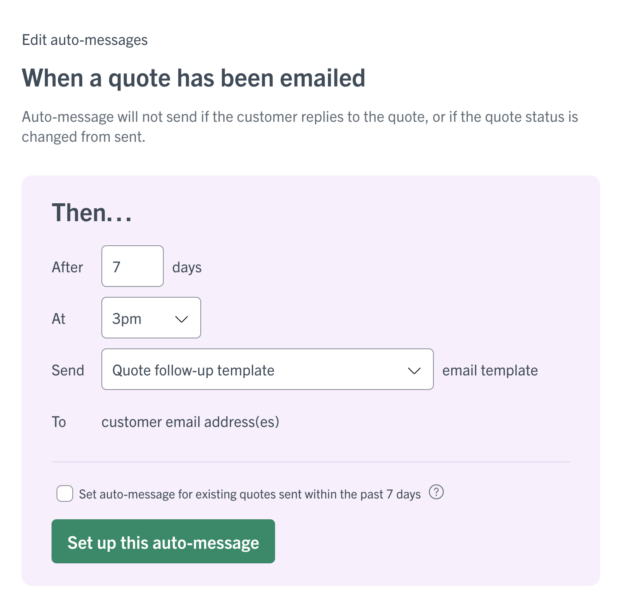
Auto-messages will auto schedule
Once you’ve set up an auto-message, YourTradebase will schedule that auto-message to send at exactly the right time.
So if you email a quote to a customer, any follow-ups will automatically be scheduled to send:
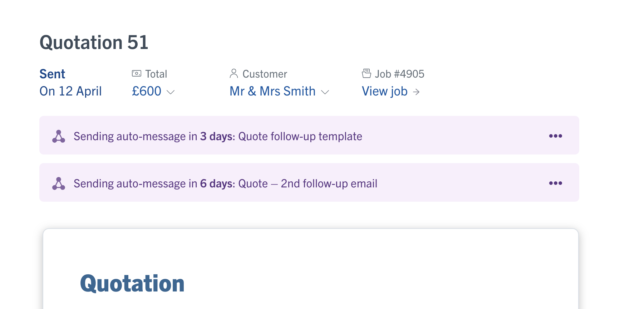
You can see a preview of exactly what will be sent, to make sure you’re happy, or stop any auto-message from sending.
More auto-messages… coming soon
For now, you can setup and send auto-messages to follow-up quotes, but we’ll be adding many more auto-messages over the coming weeks, to help you automate more of your customer communications.
We think you’ll be saving a ton of time, winning more work, and getting paid sooner by sending the right messages at the right time. Happy messaging!
The VAT reverse charge kicks in on 1 March 2021
23 February 2021
If you’re a VAT-registered trades business, there’s a big change coming your way this Spring. On 1 March 2021, HMRC is bringing in the VAT domestic reverse charge for building and construction, and it’s set to change the way you charge and pay VAT.
Sounds kind of boring and complicated? Well yeah, it’s tax. But let’s break it down, make it simple and get you ready…
The reverse charge is a whopping great change to the way VAT is collected in the building and construction industry. It’s being brought in to reduce fraud and, as with any big change, it’s going to take a bit of getting used to. The good news is, we’re here to help.
Who does the VAT reverse charge affect?
The VAT reverse charge only affects VAT-registered tradespeople and businesses that report payments through the government’s Construction Industry Scheme, or CIS.
It applies to businesses that supply building and construction services, and businesses that buy those services – so subcontractors and the main contractors they work for. If you’re a VAT-registered builder and you subcontract part of a project to a VAT-registered plumber, plasterer, decorator, electrician or other trade, it applies to both of you.
It doesn’t apply to end users, like the people or businesses who’ll use the property that’s being built or worked on. It also doesn’t apply to what the government calls intermediary suppliers – people like procurement teams, landlords and property developers who aren’t actually providing any construction services themselves.
The reverse charge only kicks in if both the supplier and buyer are VAT and CIS registered, and unlike CIS it doesn’t just apply to labour, but also to any materials supplied along with it.
Not all construction services are included…
But we think most of the UK trades using YourTradebase will probably be subject to the VAT reverse charge. It applies to ground and prep work, the construction, alteration and repair of buildings, the installation of heat, light and power, and internal and external decorating. It doesn’t apply if you’re repairing building services like heat and power.
If you’re not sure which of those brackets you fall into, or you think you’re in more than one, it’s a good idea to give your accountant or bookkeeper a ring and talk it through.
What’s actually changing?
At the moment, if you’re VAT registered and you do some work for another trade business, you include VAT on your invoice, they pay it to you, and you pay it to HMRC when you do your VAT return. As the same suggests, the VAT reverse charge turns that around.
So, from 1 March 2021, when you write your invoice, you’ll still show how much VAT is due, but it’ll be payable directly to HMRC, instead of to you. The customer will pay you what they owe you, then they’ll pay the VAT straight to HMRC when they do their own VAT return.
What does that mean for trades businesses?
Well, if you’re VAT registered, you need to be aware of whether your construction customers and subcontractors are VAT and CIS registered too.
If they’re not, you’ll handle their invoices and related VAT payments exactly as you do now. No change, no worries. But if they are, you’ll need to apply the VAT reverse charge. That means showing the amount of VAT due on your invoices, and clearly stating that it’s due to HMRC, not to you, passing responsibility for paying it onto your customer.
Whether you’re a contractor or a subcontractor, it’s a good idea to keep clear records of any VAT reverse charge transactions, so you know what’s due and who’s paying it. The way you fill in your VAT return will be slightly different too and you can find out more about that here, or by talking to your accountant or bookkeeper.
Are the VAT rates or reclaim rules changing?
In short, no. But some tradespeople will find that because they’re charging less VAT, their cashflow takes a hit and their VAT returns are more about reclaiming money than paying it.
If that’s you, it might be a good time to switch to monthly VAT returns rather than waiting to do yours quarterly. It’s easy to do online or, again, through your accountant or bookkeeper.
When do the changes come in?
The VAT reverse charge comes in on 1 March 2021 and applies to all transactions where a VAT invoice is issued or a payment is made (whichever happens first) after that date.
How’s YourTradebase gearing up for all this?
We’re making some changes to the way our invoicing system works, so it’s quick and easy for you to work out and clearly display how much VAT is due. Our tech team’s still working on the finishing touches, but they’ll be going live in the next couple of weeks and when they do, we’ll send out an update to walk you through the changes.
What can I do in the meantime?
If you think the VAT reverse charge might affect you, pick up the phone and talk to your accountant or bookkeeper. They’ll be able to give you specific advice about your business and any prep you need to do.
Once you’ve done that, it’s a good idea to start asking the people you regularly work for, or with, whether they’re VAT registered. That way you’ll have a heads up on whether the way you invoice or pay them will need to change.
Finally, you can also find loads of information on the government website, including a practical webinar that talks you through the VAT reverse charge in a lot more detail.
We’re here to help, so keep your eyes peeled for our next update and we’ll make sure you’ve got this whole thing covered. Back soon!
Your quick VAT reverse charge checklist
- Talk to your accountant or bookkeeper before 1 March 2021
- Start asking your customers and suppliers if they’re VAT and CIS registered
- Create a new template for invoices where the VAT reverse charge applies
Finally, here’s an example provided by HMRC on reverse charge
Calculate an electrician’s labour rate
16 October 2020
For electricians, writing estimates and quotes comes with the territory. But knowing what to charge isn’t always easy. Looking after your cashflow and protecting your profits means having a clear idea how much you want to be paid for your time – but how do you work it out?
We’re here to help. If you’re wondering what electricians charge, how to calculate an electrician’s labour rate… or just why the whole thing feels so awkward, we’ve got you. We’ve put together a practical guide to working out your hourly rate, as well as a super-handy electrician’s rate calculator that’ll help you zero in on a figure, knowing you’ve got rock-solid reasons to back it up.
Want to work out an hourly rate for electrical work? Let’s do this…
You’ve trained up, tooled up and built up your experience. You get there early, you work hard and you put in the hours – so you deserve to get paid properly for what you do.
The trouble is, nobody likes talking about what they earn, and everyone worries about what customers are prepared to pay… which makes settling on an hourly or daily rate for electrical jobs about as easy as finding your van keys in the dark.
It’s uncomfortable stuff. We get it. But it’s the only way to make sure you’re getting the cash you need to stay afloat, look after your business and do the things you love. So, we’re going to break it down, look at the costs you’ve got to cover and give you a practical, no-nonsense framework for setting your prices. Ready? Ok then…
Nobody likes talking about pricing. But nobody likes getting underpaid. Tweet thisWhat’s the average salary for a UK electrician?
The best way to calculate your electrician’s labour rate, is to start with the big picture. How much do you want to earn per year? It’s another tough one to put your finger on, so let’s look at what other electricians are up to. What’s the average salary for a UK electrician?
Well, ask the internet how much electricians earn per year and you’ll quickly find there’s no simple answer. According to the Office for National Statistics, the average is around £33,000 a year, but that’s a median figure, which means 50% of sparkies earn more, and 50% earn less. The same goes for hourly rates too, ranging anywhere from £20 to £70 an hour.
Why such a big variation? Well, all kinds of things can push an electrician’s earnings up or down, including experience, type of work, whether you’re employed or self employed, and where you’re working. Electricians’ daily rates and annual salaries are inevitably higher in London and the South East, but then so is the cost of living, rent, running your business etc.
Electricians are consistently the highest earning trade, and wages are increasing year on year. Tweet this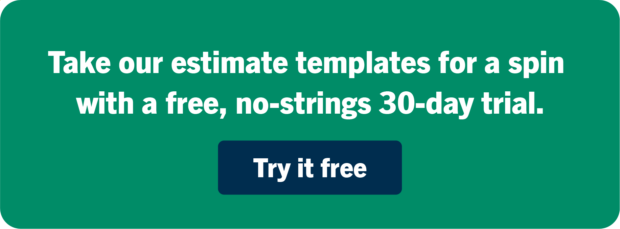
What does your electrical business need to bring in?
With no easy way to compare yourself to the competition, how do you calculate your electrician’s labour rate? Well, the best place to begin is with what actually works for you. How much do you need to earn as an electrician to make sure your bills get paid, there’s food on the table, clothes on the kids and dinner in the dog?
Break those basic costs down, come up with a ballpark figure per month, times it by 12 and you’ve got a minimum amount you need to keep you and your family ticking for the year. Let’s call this your essential costs. The stuff you really can’t do without.
But life’s not just about getting by. You don’t graft all day just to make the bare minimum. So let’s factor in some of the stuff that makes it all worthwhile – a holiday, a few days out, a few pints with your mates, a curry on a Friday night. Work out what you’d like to be able to do, and a total cost per year. We’ll call this your comfort costs. The things that get you through the week.
Finally, think about the costs of running an electrical business. What does it cost to run your van for a year? To insure it, tax it and fill it up with petrol? How about insurance, phone bills, accountants, advertising, tools and work gear? Add all of those up and you’ve got a yearly figure for keeping your electrician business going. We’ll call this your business costs.
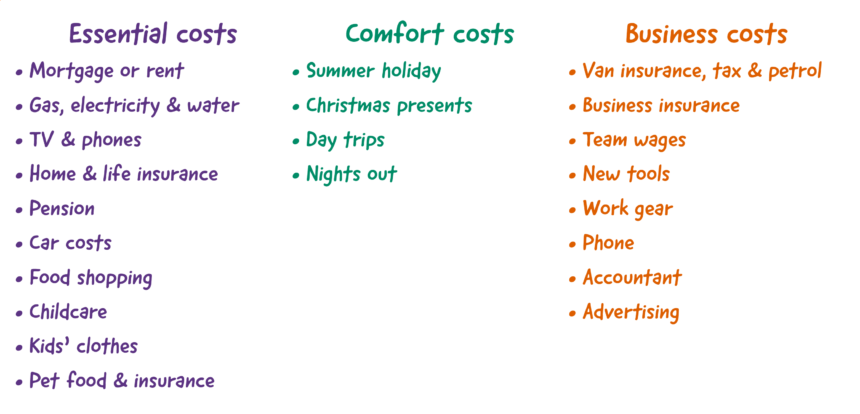

So, getting back to that annual salary, if you want to live comfortably (rather than on the edge of your seat), have the odd holiday and not be constantly worrying about making ends meet, you’re looking at: essential costs + comfort costs + business costs = minimum annual salary.
Of course, that’s just a baseline and you might well want to aim higher. Use your minimum annual salary as a starting point and set yourself a realistic target salary based on it.
Don’t forget, whatever salary you aim for, you’ll pay income tax out of it, which might affect your ability to meet those essential, comfort and business costs. To make sure you’re covered, check your tax rate and think about adding extra to your target figure to cover it.

Calculation 1:
essential costs + comfort costs + business costs = minimum annual salary.
Calculation 2:
minimum annual salary + ambition + tax
= target salary.
How to work out an electrician’s hourly rate
Once you’ve got your target salary, you can use it to calculate your electrician’s labour rate. Start by dividing your target salary by the number of days a year you want to work, minus holidays. According to Gov.uk, most employed people are entitled to 5.6 weeks’ holiday a year. As a self-employed person, you might want to match that, at least for starters.
On the other hand, you might want to go all-out for a couple of years and work even more – or take take things a little easier and work less. Decide what feels right for you – we’ll walk you through the maths so you can see if it’s workable, and you can play with the figures in our electrical rate calculator until you get the balance right.
So, target salary ÷ working days per year = your electrician daily rate. Divide that electrician daily rate by the number of hours you’d like to work per day and… Bingo! There’s your hourly rate too.
✏️ Pro tip:
Let YourTradebase do the maths. Scroll down to try our free electrician’s rate calculator.
Breaking it down: an example electrician’s salary
Here’s how that might work in practice. Say for instance you wanted to aim for a target salary of £33,000, take 6 weeks’ holiday a year and work 8 hours a day, 5 days a week.
Realistically, you won’t always be able to charge for every hour of your working day – you’ll be travelling, picking up materials, pricing up jobs, all sorts of stuff that takes you away from your hands-on, billable work. So, let’s allow for 6 of those hours a day being billable, absorbing the cost of those non-earning hours. Here comes the maths…
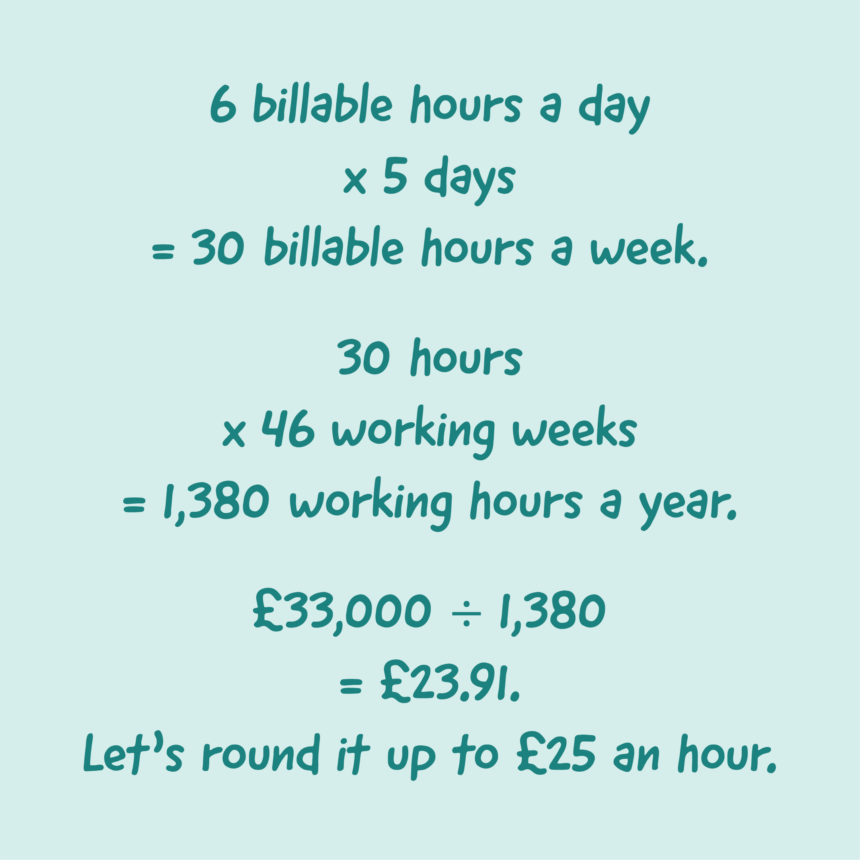
Of course you can (and probably should) charge more than that. It’ll give you more of a safety net, keep you comfortable if things go quiet, and possibly even help you look more of a pro. But if you don’t know the minimum amount you can charge, you don’t know where to start, right?
A quick way to calculate your electrician’s labour rate
If that feels like a lot of maths to get your head around, don’t worry, we’ve got you. Our quick electrician’s rate calculator does the tough stuff for you. Give it a go, play around with the numbers and get a clearer idea of what you can charge, how much you can work, and what you could be taking home at the end of the day.
Remember, the electrical rate calculator’s only going to do the maths based on what you tell it, so you still need to take a good look at the hourly rates it gives you to check whether they feel like reasonable, realistic figures you can quote to your customers.
Try our free electrician’s rate calculator
Remember, you’ll have to pay income tax out of this figure, but if you’re registered for VAT or sales tax, you’ll be able to charge that on top.
✏️ Pro tip:
Save your labour rates in YourTradebase and we’ll add your quotes up for you.
Write electrical quotes quickly and confidently
Once you’ve got a clear idea of what you need to charge to cover your costs and hit your earnings targets, it’s easier to stick to it every time you quote. You’ll have a ready-to-go hourly or daily figure that helps you feel more confident and justified in your pricing – which means you can crack on and quote electrical jobs faster.
In YourTradebase you can even set an emergency call-out rate for late-night, weekend or bank holiday jobs, so you’re getting a fair price for giving up your free time.
✏️ Pro tip:
Everyone deserves a pay rise every now and then, so review your rates once a year to check they’ve got you covered.
Boost your billable hours with YourTradebase
One sure-fire way to earn more as an electrician – without working longer – is to increase the ratio of billable hours to working hours. You might be working hard all day, but if you’re spending too much time on paperwork, you’re missing out on the chance to get hands-on and earn more.
YourTradebase saves tradespeople an average of a day a week on paperwork – a whole day you could be rolling up your sleeves and bringing in extra cash. It’s a made-for-trades toolkit full of quick, easy ways to blast through electrical estimates, quotes, invoices and more, sending out smarter stuff sooner, and winning more work, week in, week out.
How to price and estimate electrical jobs (to win!)
24 September 2020
Pricing electrical work when you’d rather be on the job (or the sofa) isn’t much fun. If you’re like most electricians we know, you probably hate being pulled away from hands-on work, or spending your evenings up to your eyes in quotes and estimates. And if all that paperwork doesn’t bring the work in, it’s easy to feel you’ve wasted your time. We get it. We’ve been there.
How to write electrical quotes, fast
The good news is, there are a few quick, easy ways to make your electrical quotes and estimates stand out – maximising your chances and making sure your time’s well spent. In today’s blog, we’re going to walk you through them step by step, looking at how to price and estimate electrical jobs faster, and better, so you can win more work. Ready?
First things first… why are quotes and estimates so important?
Pricing electrical work properly gives customers peace of mind and confidence about their project. Quotes are a really important way for them to compare tradespeople, see how you’ll handle the job and make a decision about who they’d like to use.
When customers ask for a quote or estimate, they’re not just trying to find the best price, they’re trying to make sure they find a knowledgeable, trustworthy electrician to work with. In fact, both Citizens Advice and The HomeOwners Alliance recommend customers get three written quotes before they give tradespeople the go-ahead.
Quotes and estimates also set expectations about the electrical work you’ll be doing, so everyone’s clear on what the job involves, and how you’re intending to approach it. As well as reassuring the customer, this can help to protect you if disagreements come up later.
What’s the difference between a quote and an estimate?
It’s really common for people to get quotes and estimates mixed up. Lots of customers – and even tradespeople – aren’t clear what the difference is. But there is one. And it’s a biggie. We’ve written loads about it in our quotes vs estimates blog, but here’s a quick recap:
- Estimates are a rough, informal idea of price, useful for giving your customer a ballpark figure before you’ve seen the job in person. They can change significantly once you’ve visited the site and got a concrete idea of what’s involved.
- Quotes are a formal agreement between you and your customer that you’ll do the electrical work described, for the price given – and they can be legally binding.
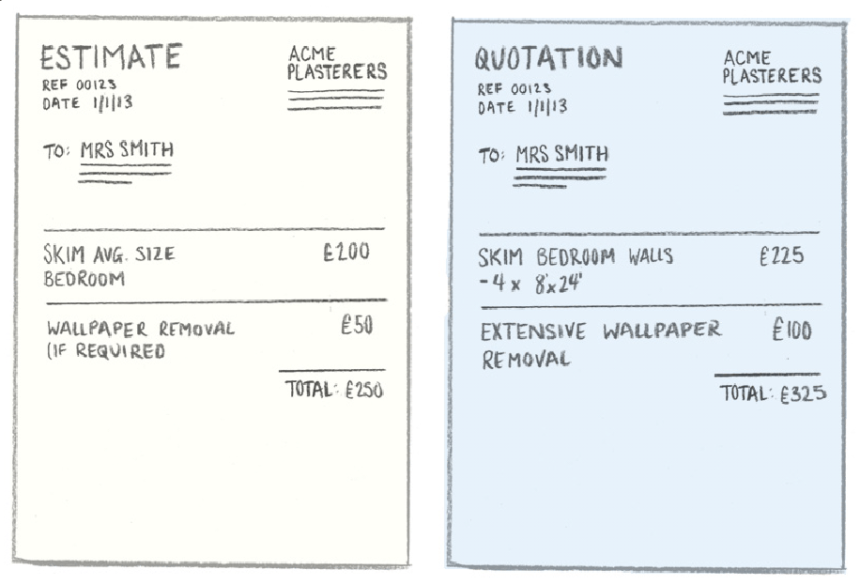
It’s really important your customer understands the difference between a quote and an estimate so aren’t upset if you need to increase your estimate once you’ve taken a closer look at the job.
💡 Tip: If you’re writing an estimate, give a few examples of things that could increase the cost if they crop up, like the customer’s current wiring failing an electrical safety test and needing fixing.
💡 Tip: Even though estimates are only a rough guide, they can still help you make a good first impression, so make them smart, clear and professional.

How soon should I send my estimate or quote?
The sooner the better! If you’re writing an estimate, try to send it out the same day. You’re only giving a ballpark figure, so if you’ve done a similar project before, get a head start by looking back at what you charged. Just be clear with them that the price could change when you see the job.
And if you’re writing a quote, try not to keep your customer waiting more than 48 hours. They want to make a decision and get on with the job, so make a good impression and help them out.
💡 Don’t let quotes and estimates build up. There are great tools out there – like YourTradebase – that can help you knock out great-looking paperwork in minutes. So take five in the van and get it all down while it’s fresh in your head. You can even send it there and then. You’ll be less likely to forget important details, your customer will appreciate the speedy response and you’ll have more time for your friends, family and sofa later!

What’s the best way to price up an electrical job?
If you’re wondering how to price and estimate electrical jobs better, there’s one box you’ve really got to tick. Whether you’re quoting or estimating, the figure you give needs to cover your labour costs + your materials. So how do you work them out?
- Labour costs: Make sure you’ve got an hourly rate for your labour, so you can use it whenever you’re pricing electrical work. It needs to cover your business overheads and add up to enough money each year to keep you and your family comfortable. There’s loads more on working this out in our blog, how to calculate an electrician’s labour rate.
- Materials costs: From cables to consumer units, sockets to switches, the price you give your customer needs to cover all the materials you’ll use on the job. As well as the actual cost of the materials, make sure you include a markup so you’re getting paid for the time it takes you to order, collect and bring those materials to site.
Get into the habit of learning from every job, by keeping track of your quotes and whether each job was actually profitable in the end. That way you’ll be able to use your prices again as a starting point for similar jobs, without losing out or starting from scratch.
💡 Tip: YourTradebase automatically saves your tasks and prices in your personal price list, so you can pick and choose whenever you quote – saving a truckload of time.
Build a personal price list & quote faster with YourTradebase.
How should I write my estimate or quote?
There are lots of tools out there for writing up your prices, from a biro and a bit of paper to specially designed, time-saving apps. So what are the pros and cons?
Writing by hand
Pros:
- Doesn’t take any training
- No need for the internet… or electricity
- Er… we’re struggling for positives with this one!
Cons:
- You only get one copy
- It might not be easy to read
- It doesn’t look professional or reassuring
Word or Excel
Pros:
- Looks more professional
- No problem understanding handwriting
- You can save, print and email copies
Cons:
- Can be slow and tricky to set up
- Hard to make it look really good
- You end up with loads of files to keep organised
Installed software
Pros:
- Looks professional
- Easier to make multiple copies
- Easier to save and re-use quotes (sometimes)
Cons:
- Can be really expensive
- You’re chained to your home / office computer
- Takes time to install, maintain and update
- Can take time to get to grips with
Quoting apps
Pros:
- Looks professional
- Easy to save and re-use your prices
- No need to download anything
- Easy to quote on the go
Cons:
- Usually a cost of some kind
- Can be a learning curve

What should I include in my electrical estimate or quote?
For starters, think about what your customer might expect to see, what’s going to help them… and what’s going to knock their socks off. If you can cover all of those bases, you’ll have a really stand-out quote with a great chance of winning the job. Let’s take a closer look…
What do customers expect to see on an electrician’s estimate or quote?
- Their name and address. Make sure everything’s spelled right!
- A breakdown of the work involved. Be clear and detailed – it’ll make you look professional and help to avoid any confusion or argument later on. It’ll also give your customer peace of mind about what they’re getting – and for how much.
- The total price. Make sure it’s clear whether this includes any VAT or taxes.
What is it helpful to include on electrical estimates or quotes?
- How long the estimate or quote is valid for. This can protect you from having to stick to your prices if the customer takes a long time to go ahead with the work – or materials costs go up. It also adds some gentle urgency, helping to put a time limit on the customer’s decision making.
- Whether your customer needs to pay a deposit, and by when. If you’re pricing a large electrical job, or buying expensive materials, you might prefer to be paid some of the cost up front. If so, be clear about your payment schedule and what you need to get started.
- A reference number. This is just as helpful for you as for your customer, making it easier to find quotes quickly if anyone has any queries. It’s also a really simple way to look more organised.
- Terms and conditions. You can include these with your quote or estimate, or just add a link to your website where they can find them in full. Either way, you’ll be helping to protect both of you by making everything super clear, up front. Again, it’ll also make you look like a professional they can trust with their electrical project.
- Your VAT number, if you’re VAT registered. Again, this gives people the peace of mind that your business has been properly registered and is paying tax.
What’s going to make my quote or estimate really stand out?
- Smart presentation, including a clear (not fuzzy!) logo.
- Your full contact details. Showing you can be easily reached is reassuring for the customer and comes in pretty handy when they want to give you the go ahead.
- Logos of any trade associations you’re a member of, or any accreditations you’ve earned. They’ll help you look knowledgeable, accountable and trustworthy. And to save you hours of searching, uploading and wrestling with dodgy resolution logos, we’ve saved a whole bank of them in YourTradebase, including NICEIC, ECA, Napit and Elecsa.
- A friendly, reassuring introduction. Add this at the top of your quote (or estimate), in your covering email, or better still, in both. If you’re struggling for what to say, YourTradebase has a whole bank of ready-written messages you can use to make a great first impression.
- A clear idea of what happens if they want to go ahead. You’ve spent valuable time getting your quote or estimate ready, so don’t leave the customer wondering what’s next. Invite them to give you a ring or drop you an email if they’d like to go ahead, or to pay the deposit if you need one.
💡 Tip: It’s always good to show you’re approachable, so invite customers to ask questions if they want to. In YourTradebase they can ask questions online and even accept quotes instantly, just by clicking on your quote, on any device.
How much detail does an electrical quote need?
It’s a balance. Give your customer enough detail that they feel clear and confident about what they’re getting… but not overwhelmed. They don’t need to know the price of every cable clip.
Giving more detail than the competition can help you win a potential customer’s trust, pave the way for a smooth-running job and protect you from any disagreements later. But think about the way you describe the work you’ll be doing, and focus on what the customer will get rather than the technical things you’ll have to do to achieve it.
Marketing expert Samuel Hulick explains it pretty neatly, with a little help from Mario:
“People don’t buy products; they buy better versions of themselves. When you’re trying to win customers, are you listing the attributes of the flower or describing how awesome it is to throw fireballs?”

When it comes down to it, the customer’s buying the end product, and the benefits it brings, so for example, instead of saying: “External installation of LAP AR0506 LED PIR bulkhead black 670LM 8W”, which is pretty baffling to the customer, you could say: “Fitting an LED security light with sensor to garage wall, automatically lighting up the driveway.”
💡 Tip: In YourTradebase it’s easy to choose the level of detail you want to show, whether that’s a full breakdown of material costs and quantities or just the total price with everything included.
How can I make quoting for electrical jobs even easier?
Whether you’re writing a quote or an estimate, the biggest thing you can do is stop starting from scratch every time. Use tools that create shortcuts, help you price consistently and speed up the whole process. For example:
- Create a quote or estimate template. That way your logo, contact details, trade accreditations, VAT number etc can be already laid out, looking good and ready for you to drop in the job specifics each time. It’s easy to do in YourTradebase – just start with one of our templates, save your details and boom, you’ve got your own branded template ready to use anytime.
- Have a templated cover email ready to go. Write a message you’re happy to send out with every quote or estimate, then save it and just drop in each customer’s name and job details before you fire over their price. Or make it even easier and pick from a whole bank of friendly messages we’ve already saved in YourTradebase.
- Keep track of your prices. Make sure you know where to find prices you’ve quoted in the past, and whether those jobs were profitable in the end. That way, when a similar job comes up again, you’ll have a starting point to work from. In YourTradebase, we automatically save your tasks and prices in your personal price list so it’s really easy to look back, pick and choose.
- Have a quick, easy way to check materials costs. Lots of the big suppliers have apps you can search quickly even if you’re on site, giving you an up-to-date picture of costs and availability. There’s more on this on our blog on apps for electricians.
- Quote sooner. Less head scratching and memory jogging means quicker, more accurate quotes. And sending them out sooner helps give you the edge on the competition.
Five sure-fire rules for writing better electrical quotes
- Price up quickly
- Say whether it’s a quote or estimate
- Give a clear price breakdown
- Look smart & professional
- Add a friendly note about what’s next
What does a great quote look like in YourTradebase?
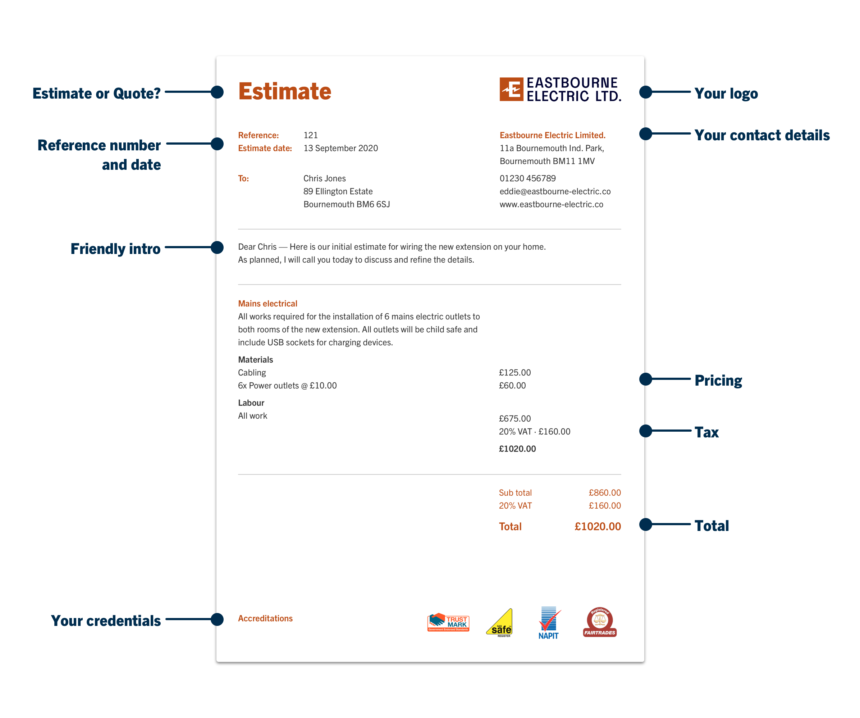
YourTradebase is the quick, easy quoting and estimating app, made for trades. It’s packed full of features that take the headache out of pricing electrical work – and help you win more jobs.
Estimating electrical work: the best software out there
22 September 2020
However hard you work, there are never enough hours in the day. And the last thing you want to fill them with is paperwork. Writing quotes and estimates takes you away from the hands-on graft that pays the bills – but what if you could crack through it faster with a few nifty apps?
There’s a whole load of powerful electrical estimate software out there, designed to help you write electrical estimates faster – and better. Which means you can save time, hassle and hard-earned cash, straight from your phone. With hundreds of electricians’ apps on the market, we’ve picked the hardest-working, easiest-to-use options – tried, tested and loved by sparkies.
Check out our favourite apps for easier electrical estimating…
Let’s face it. There’s a lot to think about when you’re pricing up a job: time, materials, travel, overheads, budgets, competition… Get it right and you won’t just win the work, you’ll go home well paid and happy. Get it wrong and you might just get stuck with an unprofitable job – while someone else scoops up the great work you can’t get to.
Luckily, there’s a truckload of helpful software for estimating electrical work out there, making it easier to price up quickly and accurately, protecting those profit margins. We know you’re too busy to sift through every electricians’ app going, so we’ve tried a bunch for you, and asked the sparkies we know.
The result? A handy guide to the best electrical estimate software you can fit in your pocket – from cable calculators that help you get a handle on the job, to mileage counters that track those travel costs. Let’s take a look.
One quick way to earn more? Get fast at paperwork. You’ll grab more grafting time, get more done and bill more, every week. Click To TweetMeasuring and calculating apps for electricians
Electrical measuring and calculating tools can really help you get your head around a job and what it’ll take to get it done. The more complex the job, the more useful they are, helping you map out what’s needed and design a safe, effective solution. And with all that at your fingertips, it’s easier to write an electrical estimate that really covers your bases…
Megger Cable Calc+
A free app from electrical heavyweights Megger, this cable calculator is a go-to tool for loads of electricians. It’s stuffed with cable options and volt drop calculations, and it’ll help you get to grips with a range of electrical testing instruments too. The best bit (apart from it being free), is that you don’t need an internet connection, so you can get instant results, whatever state your site’s in.
Electrical Tools and Reference
Electrical Tools and Reference – or The Electricians App – is a really handy chunk of software for electricians that gives you quick, easy access to a whole range of guides, tables and calculators. Print off charts, look up cable ratings, get a Zs value or do volt drop calculations. And while you’re at it, work out kVa, fault currents, ring circuits and a shed load more. Handy.
Cable Sizer
This popular app’s designed to help you make accurate cable size calculations super fast. Fill in your circuit parameters and it’ll tell you which cable to use, taking into account current carrying capacity, earth loop impedance and voltage drop – or set your own cable size and use it to check you’re good to go. Again, no internet needed, so it’s great out on site.
💡 The right tools help you get to grips with what’s needed, for electrical estimates that protect your profits.
Merchants’ pricing and sourcing apps
Some of the biggest electrical and trade suppliers now have their own apps, making it quick and easy to check costs, assess availability and order materials on the go. Less guesswork, fewer trips to the merchants and more precise electrical estimates.
As well as giving you accurate prices in seconds, some of these apps let you scan bar codes to find products faster, and most show you what’s in stock locally – potentially making a big difference to the materials you choose, as well as your travel costs and project schedule.
Every sparky’s got their favourite suppliers – whether they’re cheaper than the rest or just easier to get to – so look up your go-to merchant and see what they’ve got app-wise. You might be surprised how much easier it makes things. We like the features (and the reviews) on CEF’s app, and it’s worth taking a look at Screwfix, B&Q and Wickes too.
💡 Price up materials like a pro and make a healthy margin, every time.

Travel and mileage apps for small businesses
Getting to sites fast and keeping tabs on your travel costs can make a big difference to the accuracy of your electrical estimates and quotes – and your ability to make a profit. Which is why a couple of nippy travel apps can make all the difference…
Google Maps
These days, using Google Maps is a bit of a no-brainer. It’ll help you find the fastest route from A to B, check how many miles to factor into estimates, keep a real-time eye on traffic jams and make sure those further-away jobs don’t leave you out of pocket. But there are also some great apps out there to help you keep tabs on your mileage, without a big pile of Post-Its…
MileIQ
This handy app helps you work out your mileage expenses and it’s free for the first 40 trips you make each month. Just leave it on and it’ll automatically track how far you’ve travelled so you don’t have to remember. It sorts out your personal trips from your business ones, helping you save time – and money – every time you take the van out.
Mileage Tracker
Along the same lines as MileIQ, this app’s designed to help you track your trips and pull together all your mileage details so they’re ready to use in your tax return. As well as helping you get your annual paperwork in order, it’s a great way to get clearer on the miles you’re clocking up, so you can start factoring them in whenever you write an electrical quote or estimate.
💡 Travel isn’t free. Don’t forget to allow for your time, fuel and overheads whenever you write a quote.
Electrical estimating software for trades
We’ve looked at apps that help you scope out your jobs, price up your materials and make enough on your mileage, but once you’ve got all that figured out, what can you use to knock out great electrical estimates and quotes, in no time?
YourTradebase
Made just for trades, YourTradebase turns quoting into a quick, easy job you can fit in anytime – on the go, on site, or even on the sofa. It cuts out repetitive tasks, saves important stuff and helps you write electrical estimates faster, the more you do it.
First, the app automatically saves contact details for you and your customers, so you don’t have to add them every time. Next, it stores every task, material and project you price up, building a personal price list you can draw from whenever you quote. Once that’s done, it adds the right taxes, gives everything a reference number and tots the whole thing up for you. Boom.
You can save your branding so it drops in automatically, and even pick from a ready-to-roll library of trade accreditation and association logos (including NICEIC, ECA, Napit and Elecsa) that give your quotes and estimates extra clout. And if you’re ever lost for words, just choose from a bank of friendly quote intros and ready-written emails that’ll knock your customers’ socks off.
Finally, YourTradebase lets you fire off your estimates, quotes and invoices there and then, straight from the app. You can see when they’re opened, answer customer questions and even get instant approvals (with a signature!) right on your phone.
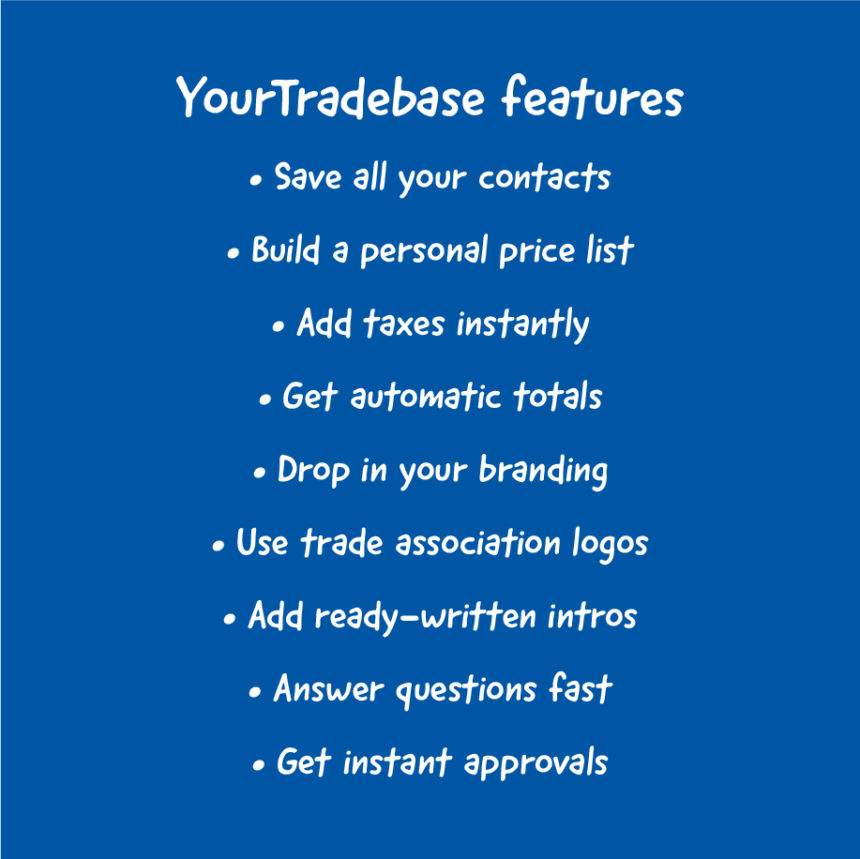
💡 YourTradebase is packed with trades-only tools that make estimating easier.
Powerful tools you can try in minutes
The right tools make all the difference. So save yourself time, protect your profits and make a great impression with electricians’ apps that really help you get to grips with pricing – from planning your project to sourcing the best products and sending a totally knockout quote.
We’ve looked at lots of helpful software for estimating electrical work, and it’s all available from the App Store, or whenever you usually get your apps. You can download any of the apps in minutes and use them today – we’ve got our fingers crossed they’ll be game changers for you.
And if you fancy trying YourTradebase, grab a free, no-strings trial today. With a truckload of quick, easy, paperwork-busting tools, it saves tradespeople almost a day a week on admin. Take it for a spin and see how much time it could save you.

The 5 most-used electrical estimating methods
21 September 2020
Ask any electrician what they love about their job, and chances are it won’t be estimating. When you’re just starting out, it’s pretty daunting – how do electricians price up work, charge for their time and estimate enough… but not too much? And even if you’re a seasoned pro, how do you know you’ve found the quickest, easiest way to estimate – or the way most likely to win work?
Worry not, we’ve got you. In today’s blog we’re looking at the five most common electrical estimating methods, and weighing up their pros and cons. We’ll break them down, look at how electricians price up jobs in different ways, and help you hit on the one that works for you – so you can price up faster, better and with a lot less stress.
The right electrical estimating methods can make all the difference
Estimates bring in work. They’re a massively important part of any electrician’s business, but we’re all guilty of putting them off, pushing them back and finding other jobs to do.
It’s easy to see why. When we don’t know what a customer’s expecting, what the competition’s quoting, or whether we’re working it out right, we’re not exactly filled with confidence… so we drag our dreaded paperwork out. Even worse, when we get estimates done and the customer goes elsewhere, it’s easy to feel like we’ve wasted our time.
So let’s fix this. Let’s pin down the best electrical estimating methods and give you an easy, effective formula that gets estimates out fast – and wins work – time and time again.
Show paperwork who’s boss and finish on time for once. Click To TweetLet’s break down the big electrical estimating methods and find the right one for you…
Ok. Everyone’s different, and what feels like common sense to one electrician might not to the next. That’s why we’re going to look at the pros and cons of five electrical estimating methods. We’ll break them down – you take your pick.
1. Time + materials
Let’s kick things off with the time + materials approach. It’s a practical, reliable electrical estimating method based on how long a job’s going to take, plus the cost of materials. As well as helping you work out ballpark estimates, it gives you enough detail for full electrician’s quotes too (not 100% clear on the difference? Check out our Quotes vs Estimates blog).
You’ll need a couple of things to get started with the time + materials approach. First, a clear idea of what your hourly rates are. Working out a realistic rate that covers your living and business costs gives you a solid starting point for more confident, consistent estimates and quotes. If you need a hand, read our blog on how to calculate your electrician’s labour rate.
Second, you’ll need a quick way of costing up electrical materials. These days most suppliers have websites and some even have apps that speed the process up (check out our quick guide to great apps for electricians for some tips). Don’t forget to mark up your materials to cover your time sourcing them and getting them to site.
The pros
This formula-based framework makes sure you cover your costs, get paid at a decent rate, charge the right amount for materials and don’t lose out. It’ll give you the confidence that there’s strong reasoning behind your prices, which you can break down in detail if need be, showing how honest, methodical and professional you are.
The cons
It can be nerve-racking to work out a labour rate, (although this blog will help) and even if you work out how many hours the job needs, there’s a chance it’ll run over. That’s a risk, whatever electrical estimating method you use, but at least if you’ve listed your expected hours, you stand a chance of convincing the customer the job was more complicated, and negotiating a little extra.
Go with it if…
You like the idea of a strong formula that covers your costs.
Avoid it if…
You’re uncomfortable setting an hourly rate (you shouldn’t be!).
✏️ Pro tip:
Save regular materials prices in YourTradebase for faster estimates, every time.
2. The guesstimate
Next in our run-through of electrical estimating methods… the guesstimate. Otherwise known as pulling a figure out of the air based on your experience and assumptions. Yes, it’s about as precise as it sounds, but remember an estimate’s a ballpark figure rather than a price you can be held to. When it comes to full-on quoting, it’s risky, so tread carefully.
The pros
It’s certainly quick… with a whole lot less working out. And if you’re very experienced, it might just be reasonably accurate (fingers crossed). We’re struggling for more plus points though.
The cons
Without a real basis for your figures, you’re more likely to undercharge or overcharge, which could leave you out of pocket, put potential customers off or even lead to disputes later on. And if your customer feels you’re guessing, it won’t make you look very professional, or generate much faith.
Go with it if…
You’ve got tonnes of experience and you’re super clear it’s a ballpark figure.
Avoid it if…
You’re new to the game or your customer wants a definitive price that won’t change.

3. Working to a budget
Onto our next electrical estimating method – and this one’s a little different. The working to a budget approach puts your customer in control. Just ask them what their budget is for the electrical work, then tell them what you can do for that price. It’s more suited to projects than quick hour-or-so jobs, but it’s worth thinking over.
The pros
When it goes well, this electrical estimating method can be a real people pleaser. Your customer feels they’re in the driving seat, being listened to and accommodated – and they’re comfortable with what they’re spending.
From your point of view, as long as the budget they give you is realistic, you’ll know the price you’ve got to hit to get your estimate accepted. Less guesswork for you (but more for them).
Finally, there’s always the chance your customer totally overestimates and gives you a nice big budget, so you you can put in a comfortable estimate with a guaranteed profit, and still make them happy by coming in for less. If there’s still a lot of budget left when you’re finished, you could even bring the final price down – a powerful way to win trust and loyalty.
The cons
Most customers have no idea how long electrical jobs take, or what expertise and materials they involve. You’re the expert, so it’s a risky move to put the pricing in their hands.
If you know they’re taking the same approach with competitors, it puts a lot of pressure on you to come in below what might already be a pretty low budget. And if you can’t possibly do the work for their budget, you’ll be on the back foot before you’ve even put in your price – not a great start.
Go with it if…
You’re confident they’ve got a decent budget or happy to tell them if they’re way off.
Avoid it if…
You feel you might be squeezed on price or they seem like a tricky customer.

4. Picking from a price list
The price list approach (also called a schedule of rates) is used by thousands of sparkies as a really useful way to write estimates or quotes quickly. It involves using your experience, along with a good understanding of your hourly rate and materials costs, to build a ready-to-go list of prices for regular jobs like installing new power points, changing LEDs or putting up lights.
The pros
This electrical estimating method is super useful for jobs you do week in, week out. You know what they involve because they’re your bread and butter. In fact, you could practically do them in your sleep, so there’s no need to price from scratch every time. Whether they’re small jobs or bigger projects, if you know you can deliver for a certain amount, it’s a great short cut.
As well as speeding up your estimating and quoting, the price list approach encourages you to learn from experience and keep track of your prices, so you can get faster and more accurate at pricing up the more you do it. Plus, if you want to find out what the competition’s charging, it’s easier to ask someone what they paid for a specific task and benchmark yourself against it.
In YourTradebase, we actually help you build your price list with every estimate or quote you write. Our app saves your prices automatically, so you can pick and choose from them next time.
The cons
A job that might initially seem the same as a previous one could prove more complicated, so only use your price list when you’re confident you know the score. For extra protection, include plenty of detail in your estimate or quote, so if the actual job demands something different, you’ll at least have a basis for negotiating more money.
Go with it if…
You do the same tasks regularly and want to get faster at pricing up, every time.
Avoid it if…
You rarely do the same job twice.

5. It takes as long as it takes
This one isn’t so much an electrical estimating method as a state of mind. The it takes as long as it takes approach is a way of working with long-term customers that depends on (and fosters) trust and loyalty. Do what’s needed, keep tabs on your costs and tell them the price at the end.
The pros
If you’ve got a strong, established relationship with a customer and they’re happy to work this way, great. It means if you’re honest with them and get the job done in a reasonable time, you’ll never be out of pocket for the work you’ve done – every hour gets paid for. You’re building a partnership based on trust, mutual respect and clear communication.
The cons
Fallouts happen, and this approach does leave you open to disagreements over price, which could leave you with less money than you deserve – and little legal backup. Don’t rush into this kind of agreement until you’ve done a handful of properly estimated jobs for the customer.
Go with it if…
You’ve been working together for years, you trust each other and you talk regularly.
Avoid it if…
You don’t know the customer well or you have any doubts at all – trust your gut.
✏️ Pro tip:
Track all your customer messages automatically in YourTradebase.
Which electrical estimating method is right for you?
There are pros and cons to every electrical estimating method, so it all comes down to the kind of jobs you do, the kind of customers you’ve got and what you feel most comfortable with.
While the working to a budget approach creates certainty for the customer and the takes as long as it takes route can help to cover every hour you work, the time + materials and price list based approaches are the safest, most professional options in our experience.
They give you a great formula for speeding up the quoting and estimating process, building your confidence and creating shortcuts you can use again and again.
They also interlink – the price list approach has its roots in a great understanding of time + materials. So once you’ve worked out how much time and materials you need for a regular task, it can become an item on your price list, without you having to do those calculations every time.
A faster way to work out your prices
Building a price list in YourTradebase is really, really easy. In fact, we do it automatically. Every time you write a quote or estimate, we save each task to your price list so you can pick and choose from it the next time, and the next. So without any extra work, you get a super useful shortcut that speeds up the whole process, based on the prices you personally want to charge.
With quick estimate templates, a library of trade logos, easy ways to save your details and ready-written customer messages, YourTradebase also makes writing up and sending your prices really fast and polished too. You can even answer customer questions and get instant approval online – going from first enquiry to shiny green light faster (and more painlessly) than ever.
A sample electrical estimate
14 September 2020
However much you love the hands-on, boots-on graft of being an electrician, paperwork’s an inevitable part of the job. Busy sparkies write electrical estimates and quotes week in, week out. But how do you know you’re nailing it? What’s the best way to price up electrical work? And when it comes down to it, what should an electrical estimate include?
We know you’re up against it, so we’ve put together a knockout electrical estimate template you can use again and again. It’s got bells, it’s got whistles and most importantly, it’s got all the great stuff you need to win electrical work. Let’s take a look…
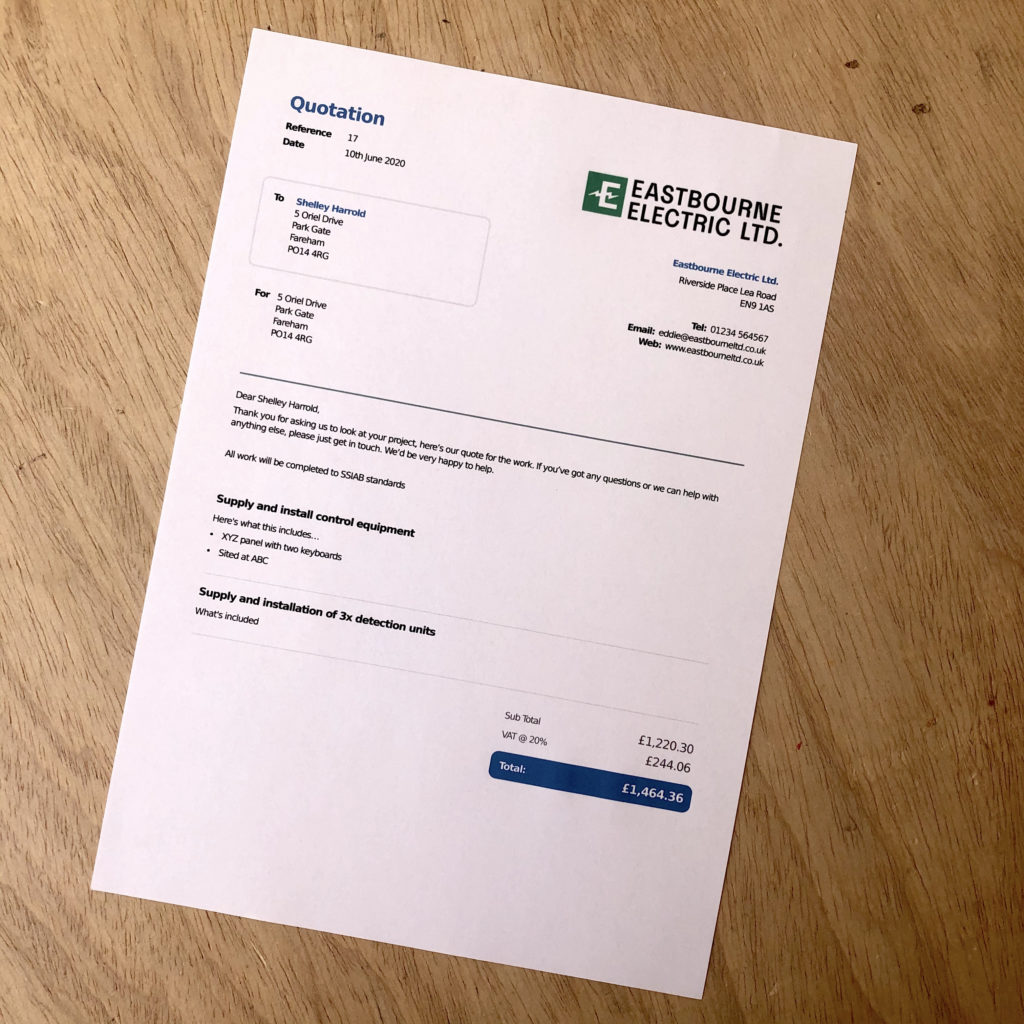
Grab a great electrical estimate template – and win more jobs
Let’s face it, you didn’t become a sparky because you love writing estimates and quotes. It eats up time, it’s a faff and it takes you away from the work you enjoy. But there’s good news – we’re here to help you stop sweating it and start knocking out work-wining estimates and quotes. And all you need to do is follow our smart, straightforward sample electrical estimate…
Paperwork isn’t the boss of you. So why is it making you work the weekend? Click To TweetWhat should an electrical estimate look like?
A handful of essential ingredients make up a great electrician’s estimate – or quote, for that matter. None of them are rocket science, but bring them together and you’ve got a clear, confident piece of paperwork that shows customers what a pro you are. And once you’ve got it right, you can use your knockout estimate as a time-saving template, again and again.
Sound good? Keep reading for quick tips on getting your electrical estimate template just right…

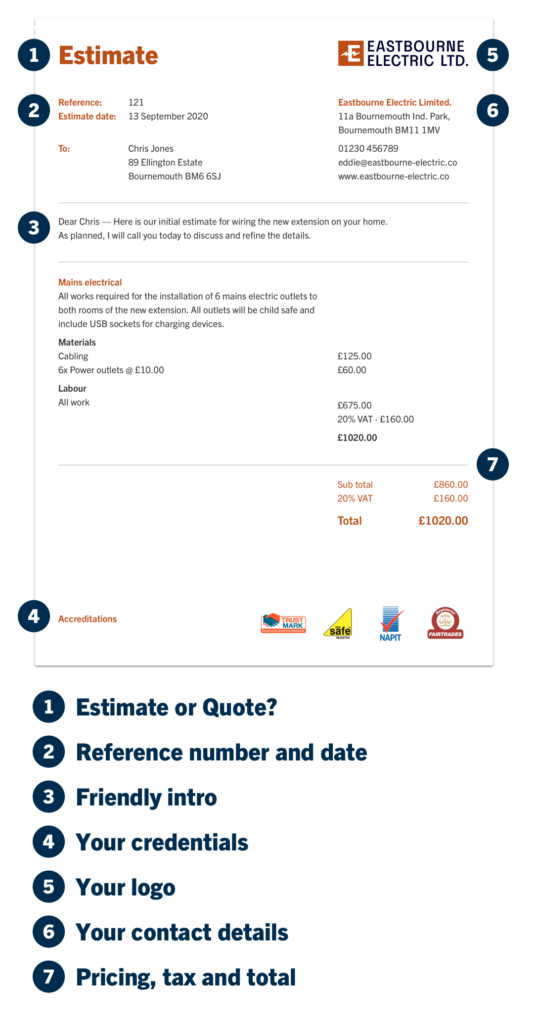
1. Electrical estimate or quote?
Let’s start at the top of our sample electrical estimate, with a little thing that makes a whopping great difference: The title. Quote or estimate?
They might seem like the same thing, but they’re actually worlds apart – and getting them mixed up could leave you in a lot of hot water. So be super clear on the difference, and make sure your customers are too.
An electrician’s estimate is a rough idea of the price of a job. It’s a ballpark figure you might be asked for up front, before you’ve done a site visit or dug into the details. It’s not legally binding and it could go up or down once you know more about the work.
On the other hand, an electrician’s quote is an exact price for a job – it can’t be changed once it’s been accepted, unless the scope of the job changes too. Don’t be tempted to send a quote till you’ve seen the job in person – it’s a contract between you and the customer and can be used as legal evidence if you run into problems.
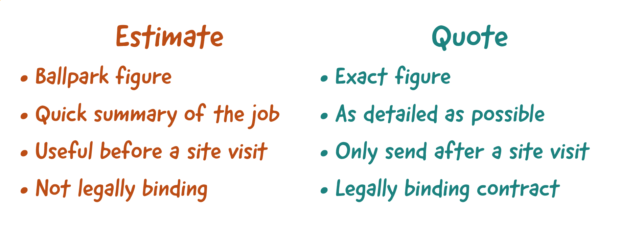
2. Give your electrical estimate a reference number
Reference numbers are another quick way to up your game – which is why we’ve used them on our electrician estimate example. Adding one whenever you write an estimate or quote makes it easier to organise your paperwork, talk to customers about prices – and find job details further down the line. They’re also a quick, simple way to look more professional.
✏️ Pro tip:
YourTradebase estimate templates automatically add reference numbers for you.
3. Date your electrical estimates – and protect your profits
Dating estimates and quotes is really important, and not just for tracking down paperwork. Customers don’t always make decisions about electrical estimates quickly, and the last thing you want is to be held to a price you gave months ago – especially if material or labour costs change.
It’s a good idea to have a detailed set of terms and conditions, explaining how long your quotes and estimates are valid for. Go for a month, three months, or whatever you’re comfortable with – it’s entirely up to you, as long as you’re clear. You can include your Ts & Cs with your electrical estimates and quotes, or refer people to your website to read them in full.
✏️ Pro tip:
Don’t get stuck with out-of-date quotes – be clear how long your prices are valid for.
4. Add a pro logo – every electrician’s estimate deserves one
Your logo’s not just there to make your van look pretty. Stick it at the top of every electrical quote or estimate and show potential customers you’re a professional. Presenting yourself as an organised, credible electrician business will give customers a reason to choose you over the competition.
We know uploading your logo every time you write an estimate can be a pain, and if you’re not an IT bod, the results can be… well, less than perfect. Which is why we’ve made it really easy in YourTradebase. There’s a handy walk-through to help you upload it the first time and, once you’re done, we’ll save it in your electrical estimate template, so you can use it anytime you like.
✏️ Pro tip:
Save your logo in YourTradebase and it’ll be ready to use, every time you estimate.
5. Provide clear contact details, each time you price up
Ok, so your customer’s asked you to price up an electrical job, but don’t assume they’ve kept your details safe. Whenever you write an estimate or quote include your full contact details, just like we’ve done on our sample electrical estimate. That way it’s really easy for people to get hold of you – and tell you you’ve got the job!
If you’ve got a website (and it’s always good to have one) include a link so people can find out more about why you’re a great choice for their project. And don’t skip that full postal address either – including it reassures people you’re a legitimate, professional business.
Tell people your…
- Full business name
- Postal address
- Phone number(s)
- Email address
- Website
But here’s the thing. Don’t waste time typing in all those details every time – use or create an electrical estimate template (it’s easy in YourTradebase) and have your details ready for next time. It’ll save you a tedious job and shave a couple of minutes off every estimate too.
✏️ Pro tip:
Save your logo in YourTradebase and it’ll be ready to use, every time you estimate.
YourTradebase automatically adds your contact details to every new estimate.
6. Add a friendly intro and give your electrician’s estimate the edge
A few friendly words can make a lot of difference to the way a customer feels about your business, so take a minute to say hello and show your customer what it’s like to work with you. Be friendly, open and professional – invite questions, clarify whether it’s a quote or estimate, and tell people you’re looking forward to working with them.
Lost for words? We’ve got you. YourTradebase has a tonne of ready-written intros you can use in your electrical estimate template to make you look like the kind of friendly, reliable human your customers want to have around.
✏️ Pro tip:
Writing a short, friendly intro can give your electrical estimate the edge.

7. Break down your electrical quote and build up trust
Now we’re getting to the nuts and bolts of it. Laying out your prices clearly is really important – both for your customer and for you. They need to know what’s involved, what you’re proposing and what each element is going to cost. This helps them know what to expect and means they can compare your prices with other electricians’ estimates and quotes.
Remember, if you’re writing an electrical estimate, you’re giving your customer a ballpark figure, but it doesn’t hurt to be as detailed as you can, so you’re managing customers’ expectations.
On the other hand, if you’re writing a quote, getting all the details down is essential. Give a clear description of each element of the work, as well as a costed breakdown of materials and labour, just like we’ve done on our sample electrical estimate.
Your price should include (but not highlight) a percentage mark-up for materials and the labour of your team. It’s a really useful exercise to think through what it’s costing you to supply those things and what percentage you want to make for your time and efforts, on top of covering your costs.
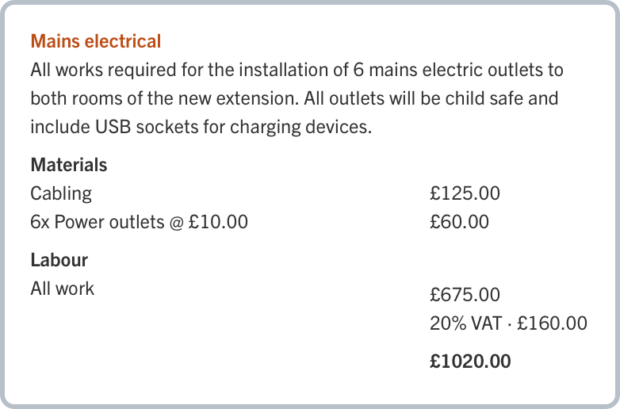
Chances are, you do similar tasks pretty regularly – whether it’s fitting a new plug socket or rewiring a 60s semi, so keep a note of the prices you’re giving rather than starting from scratch on every estimate. It’ll save you time, and help you make enough money on the jobs you do week in, week out.
If you use YourTradebase, whenever you write a quote or estimate, we’ll automatically save each item you price up in a ready-to-go price list, so you can pick and choose from it when you’re writing the next one, and the next. It’s a handy way to price up electrical work faster, with the confidence that you’re being consistent.
✏️ Pro tip:
YourTradebase helps you build your own price list, so you can quote faster every time.
8. Show taxes clearly on every electrical estimate
Customers can easily confuse pre- and post-tax totals, so whatever you do, make your electrical estimates and quotes crystal clear. In the UK, if you’re a VAT-registered electrician, you need to show VAT on your estimates and quotes, so your customers can see what they’ll be paying.
If you’re outside the UK, you might have to pay sales tax, so check where you stand and if it’s a cost you’ll be passing onto your customer, list it out clearly.
9. Check and double check your estimate total
When it comes down to it, every customer who opens an estimate or quote skips straight to one thing – the total. So, triple check you’ve got it right and display it really clearly. In YourTradebase, we automatically add up your electrical estimates and quotes to give you extra peace of mind.
✏️ Pro tip:
We’ll do the maths. YourTradebase tots up every estimate for you.
10. Flash trade credentials on your electrical estimates
Showing customers you know your stuff – and can be trusted with theirs – is a sure-fire way to get the edge on the competition. So, if you’ve worked hard to get accredited, nail that qualification or join that association, electrician estimates and quotes are the perfect place to shout about it.
If you’re a member, most trade associations will let you download their logo. But to make life easier, we’ve got a whole bunch of the biggest trade logos pre-loaded in YourTradebase and ready to use, including NICEIC, Napit and ECS. Just drop them in in a couple of clicks.

One quick, easy electrical estimate template
And that’s it. Ten smart, simple ingredients that add up to a great electrical estimate. Now you know what you need, don’t start from scratch every time. Create a template you’re happy with, drop in your business details and use it again and again.
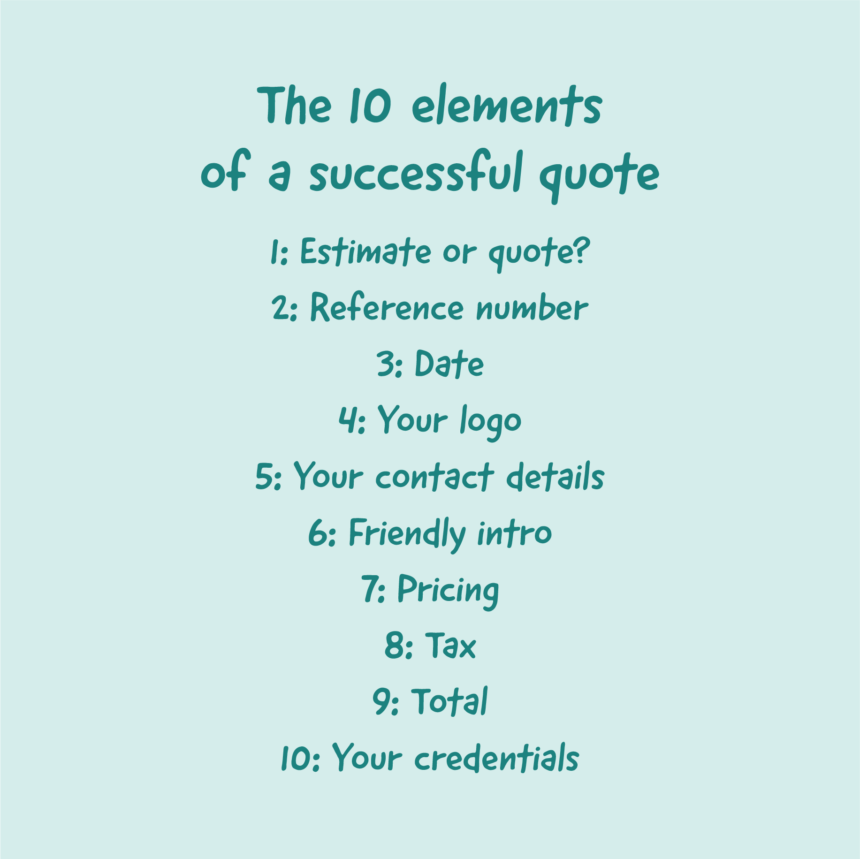
Even better, make life a whole lot easier (and work a whole lot faster) with the made-for trades estimate templates in YourTradebase. They’re just the job for electricians, plumbers, painters, builders, gardeners, roofers, chippies and more. Here’s how they roll…
COVID-19 and YourTradebase
18 March 2020
During these uncertain and anxious times, our first priority is for the well-being of our team, their loved ones, and our customers.
I wanted to share a few words about how we work, and our plans for dealing with this tough situation we all find ourselves in.
We’re fortunate to be a fully remote team, with the majority of team members already working full-time from home long before Coronavirus appeared. We’re well-practiced in working together remotely, and will be continuing to support our customers as ever.
We’ll be delivering the same fast and friendly support you’re used to during this period, whilst still working to keep YourTradebase fully operational and improve the speed and benefits we offer.
Our thoughts are with you, our customers, during these fast-changing and difficult times. We truly hope you’re able to continue your work as safely as is possible.
Please take care, and look out for loved ones and those close to us.
Best wishes,

Adam Austin
Managing Director – YourTradebase
Cold weather tips for builders…
4 February 2020
Grafting on site in the depths of winter is pretty grim, so what’s the best way to stay warm and working, however baltic it gets?
There’s a January and February (and March) in every year, but somehow the really cold weather always seems to come as a surprise. It feels like those heavy frosts, below-freezing temperatures, snowy mornings and dark days are out to get you – stopping you getting stuff done, stalling your schedule and making your building site a pretty miserable place to be.
So what’s the secret to getting through winter on site? To pushing on through and keeping your business strong? It’s all about thinking ahead and being clever with your days. Get it right and you’ll have less downtime, happier customers and a better start to your year. Here’s how…
Weather-proof your workload
Ok, so those big freezes and snowfalls tend to come without much warning, but you know it’s winter, right? Things always take longer when the conditions are bad, and there’s bound to be the odd day that’s a bit of a write-off.
So, when you’re planning winter building jobs, try to allow for that. Plan in extra time from the start and give yourself enough breathing space to work safely, squeeze in the odd emergency job (there’s always something) and still meet those (more realistic) deadlines. You’ll be glad you did.
Plan your winter workday
On short winter days, plan indoor tasks for those first and last few hours, and snatch the middle of the day for outdoor work. It’ll help you be more productive, get better results, avoid re-dos and keep your team happier too.
Some jobs, like wet trades, just can’t be done when the temperatures get too low. Mortar won’t mix, bricks might need to be re-laid, and concrete and render can crack – or take forever to get strong. You can’t change any of that. So try to plan this work for warmer months, or crank up some workspace heaters and tackle the problem head on.
Whether you buy your own heaters or hire them for the job, they’ll help materials and equipment work properly despite the weather, making them a pretty sound investment. The same goes for extra lighting, which can help you pack more hours into your day – and stay safe and well.
We’ve built a pretty nifty schedule tool in YourTradebase to help you plan jobs better. Take a quick look or hop on a free trial.
Stay warm on site
Cold, dark days bring all sorts of risks on building sites and as trades, we literally can’t afford to take them. Making yourself ill or having an accident can wipe days or weeks out – and that means you won’t get paid, you’ll miss out on work and you’ll struggle to catch up.
So stay warm. Whether you’re working outside or on an unheated site, layer up with this lot…






Remember, those extra layers might make moving around and operating equipment feel different or difficult, so take extra care, go slower if you need to, and stay safe. Some machinery doesn’t like the cold either, so go steady. It’s understandable that you want to crack on and get finished, but be realistic about what you can do and take extra care.
Keep eating and drinking
Ok, we know that’s tough. But keep the tea flowing, eat warm food if you can, and step inside often to eat or drink it. It’s really important to warm up regularly – even if that just means five minutes in the van to remember what your fingers and toes feel like.

While you’re warming up, you can always grab some van time and blast through a few quotes, send out some invoices or get back to a few customers – it’s all about using the time well to save yourself stress and hassle later. And it’s surprising how much admin you can do in ten minutes.
Get your work van winter ready
While we’re on the subject, make sure you kit out your van for cold days too. Breakdowns are much more likely when the temperature drops and if you can’t get to site, you can’t work, earn or keep your customers happy.






Sort out your trade insurance
If an accident’s going to happen, it’s going to happen in poor light and icy conditions, so make sure you’ve got good cover – for you, your team, your kit, your customers and their property. Give site security some thought too – darker days mean more risk of theft, so you might want to rig up some CCTV, lock up your site or take your tools home.
Know when to shut down the site
Some days, the weather’s just going to win, and getting the things you planned to do done… well, it’s just not going to happen. But that doesn’t mean your day needs to be wasted. It might be the perfect time to squeeze in a quick job for another customer – one of those urgent winter repair jobs or something else that’s 100% indoors.
On the other hand, it’s also a great time to get your admin in order – freeing up your evenings and weekends for all those things you’d much rather be doing. Catch up on quotes, invoices and callbacks from home – with all the no-nonsense tools and templates in YourTradebase it’s quick, easy and doable from the kitchen table, or even the sofa.
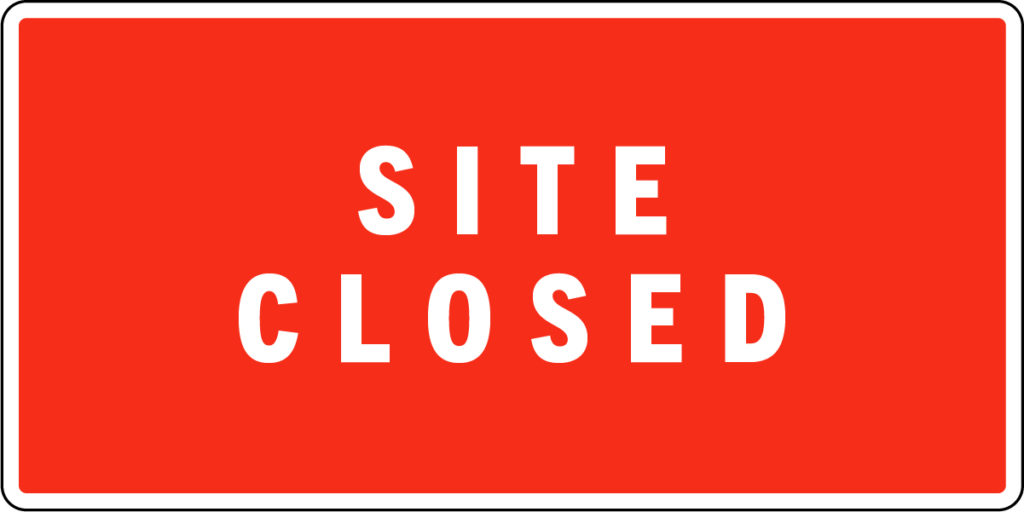
If you’ve got a bit more time, how about asking some of your favourite customers for testimonials or using our new ‘Extra customer info’ forms to give your customer records a bit of a boost? Right now you might be able to remember that Mrs Smith had a Baxi boiler and it needs servicing in September, but by the time September rolls around… well, you probably won’t.
Get all that info down – along with anything else that might be helpful, like how customers heard about you. It’ll show you what you’re doing right and wrong when it comes to spreading the word. By the end of the day, you might just have fuller records that help you promote your business, look after your customers better and feel super organised when the snow starts to melt.
Let’s do this
So, don’t wait for that freezing cold morning when the van’s a foot deep in snow. Get prepped now, have a plan for the worst of the weather and use your time to get a load more stuff done.
Keep warm out there!
Hello 2020… goodbye Word & Excel
15 January 2020
People, it’s time. Stop struggling with Word and Excel and grab a better power tool for your paperwork…
This new year, make smashing through your admin as easy as it should be.
The right tools make a massive difference. We’ve all been there, out on site, battling away with a saw that’s not sharp enough, a drill that’s not powerful enough or a ladder that’s not long enough. It’s not fun. It makes a quick job a slow one, and a great finish hard to achieve.
It’s just the same with paperwork. Struggling with tools that aren’t quite right for the job – or up to the job – makes knocking out a quick quote so much harder than it should be. Which means it takes longer to do, gets put off day after day, and doesn’t look great even when it’s done.
You wouldn’t put up with it on site, so why put up with it for your paperwork? All you’re doing is adding to your stress levels, eating up more of your evenings, and churning out admin that doesn’t do you justice. Better is out there.
Secretary or sparkie?
There’s no getting away from it – Word and Excel are powerful tools. They wouldn’t be used by millions of people if they weren’t. But one size just doesn’t fit all. And really, why should something that works for an accountant, a secretary or an HR manager be right for the best builder in Bromley, or the fastest sparky in Southend?
It just doesn’t make sense. Every other tool you use is designed for jobs like yours – so why should it be different when it comes to your admin? There are tools out there made for trades – made to suit the kind of work you do, and the kind of days you have. And those tools are a solid investment. Time is money, and they’ll help you spend more of it earning, not doing admin.
Fancy making 2020 the year you stop struggling and start using a paperwork power tool that’s right for you? Let’s take a look…
Time-saving templates
Ok, so there are templates in Word, but they’re not exactly geared to getting you paid. They might help you knock up a nice CV or report, but that’s not really what you’re after, right?
So, look for an app, or piece of software, that gives you templates you actually need – shortcuts that help you blast through paperwork faster and save a tonne of time. At YourTradebase, our reusable templates cover everything from estimates, quotes and invoices to a whole bunch of emails you might want to send.
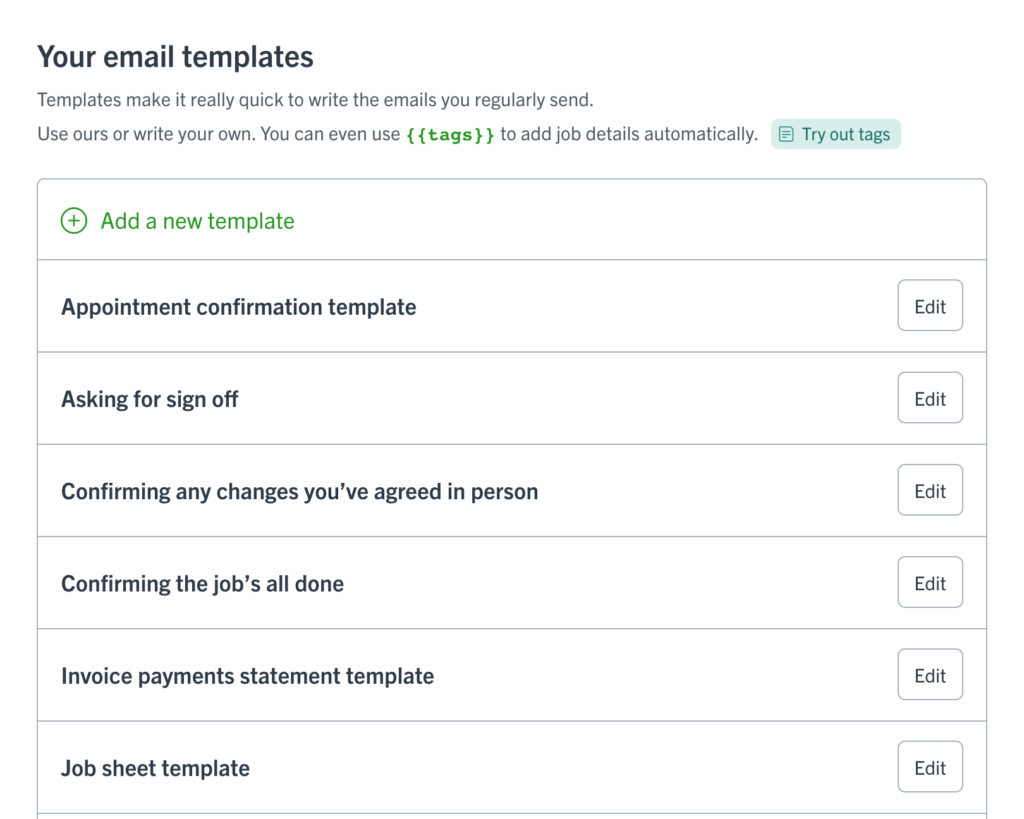
Want to chase up a quote? We’ve got a template for that. Want to agree a start date? We’ve got a template for that. Want to confirm a few changes? Yep, you guessed it. The whole point is to help you get your admin jobs done well, in a fraction of the time.
Price lists you can personalise
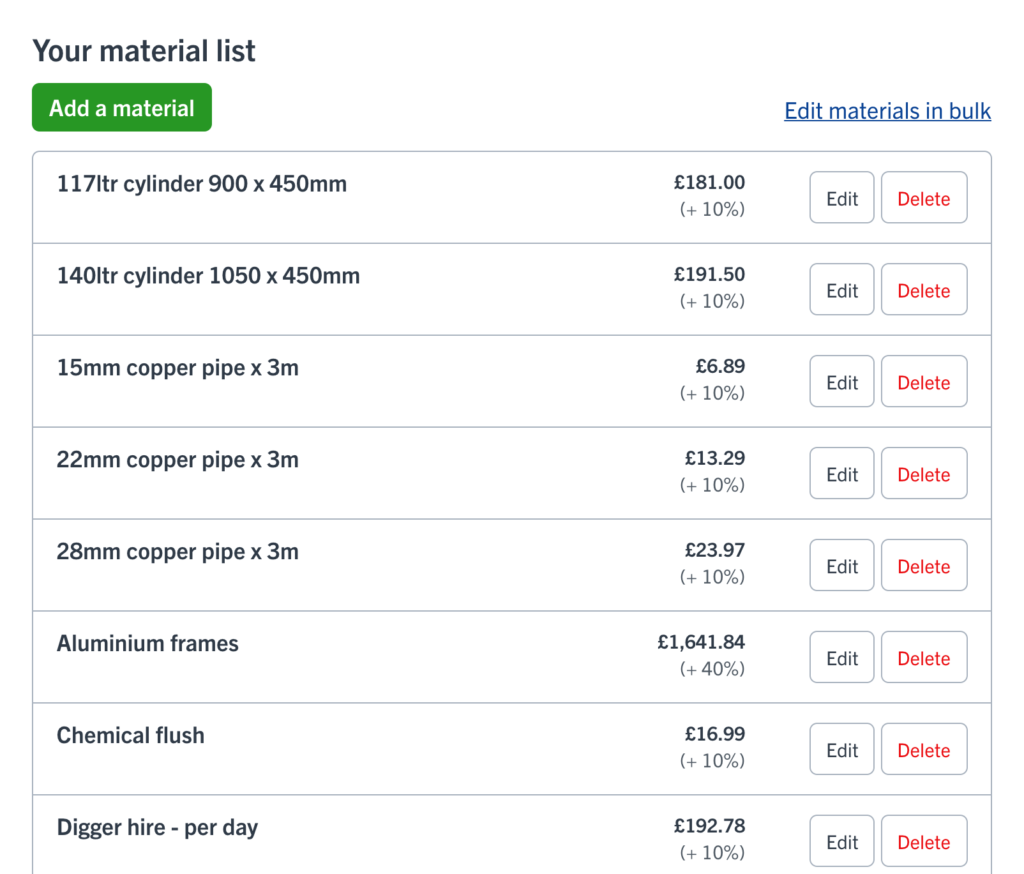
Another handy thing to look out for are price lists you can build and save, so you can pick and choose tasks, labour costs and materials you use regularly. In YourTradebase you can completely personalise them based on what you usually charge, saving you a tonne of maths time and letting you get those quotes together faster.
Paperwork you’re proud of
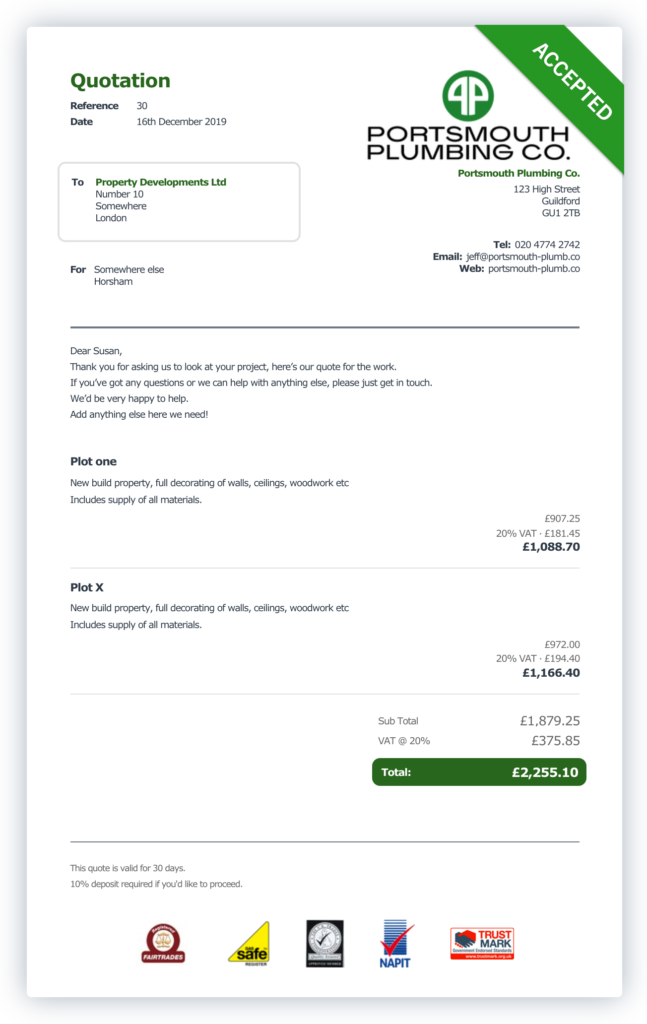
The estimates, quotes and emails you send out are often people’s first clue about how professional your set up really is. So don’t settle. Look for a system that helps you build paperwork you’re really happy with, not just something that’ll have to do – paperwork that’s complete with your logo, trade association logos and business colours.
Trying to crowbar a logo into Word can feel clumsy, unprofessional and a bit of a struggle. It doesn’t have to be that hard. With the right tools, dropping that logo just where you want it is a two-second job, helping you build quotes that give people confidence – and win more work.
Fast ways to find what you need
Trawling through files looking for old notes, quotes and job specs is a frustrating waste of time, and these days you just don’t need to do it. Tools like YourTradebase give you a joined-up way to save, store and find your paperwork, without faffing through folders or being tied to you computer.
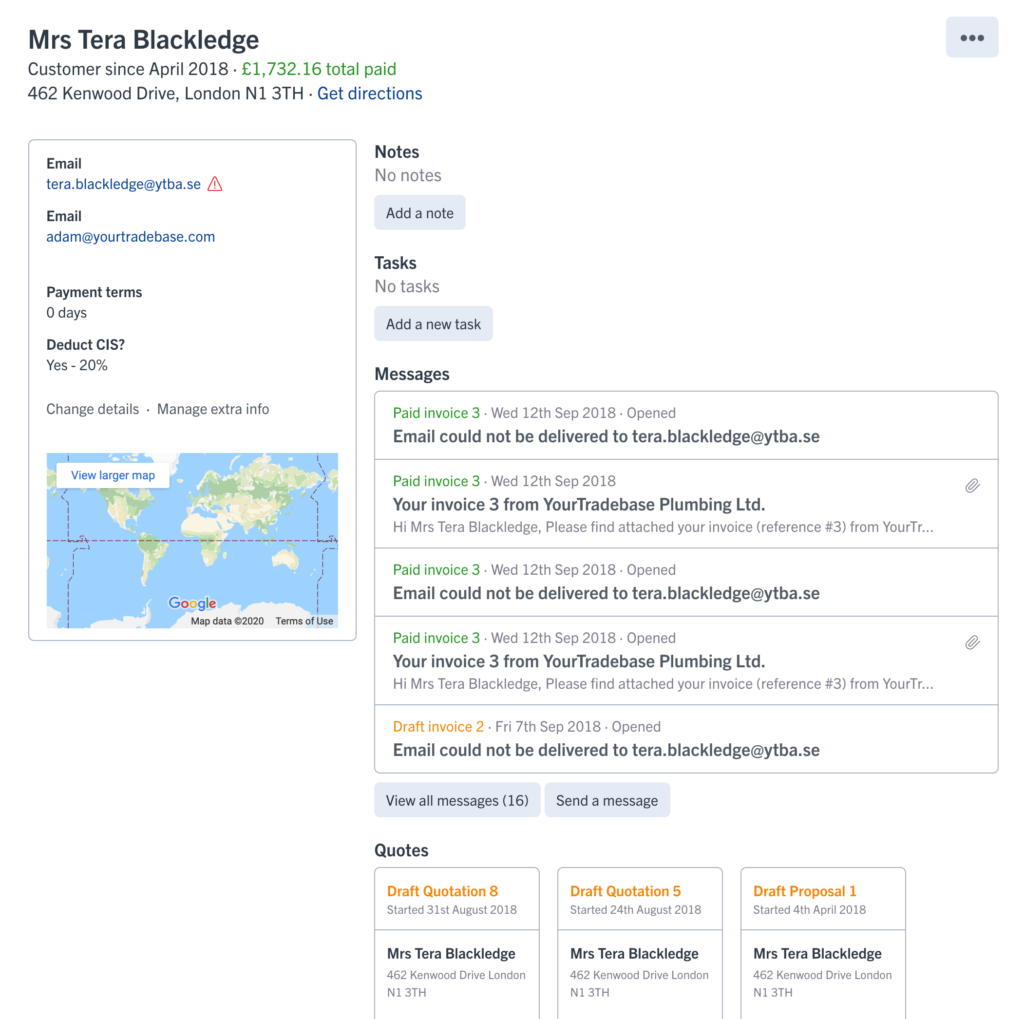
Just look up a customer and see everything you’ve ever done for them, in one place, super fast. You can even search your records on site, on your phone, with the customer standing in front of you. You’ll look super organised and they’ll feel you remember, and value, each of their projects.
Tracking, reminders and other useful stuff
However long you’ve been using them, Word and Excel aren’t going to remind you when it’s time to chase up that invoice, or tell you when your customer’s opened their latest quote. They’re just not built that way. But a tool built for the trades can.
So, take things to the next level by going for a system that lets you track your paperwork, email it instantly, see when it’s been read. A tool that tells you when customers need chasing up, rather than letting things drift. It’s about taking the pressure off you to remember everything – giving you a nudge when you need one, so you can make the most of every lead, and get paid faster.
Go your own way
The thing to remember is, Word and Excel aren’t the only way. You’ve got options – and they’re solid ones that could be real game changers for your business. Finding a system that feels right for you is really important. So try things out and see what works for you.
YourTradebase was designed by trades, for trades, and it does all of the above, plus a tonne more – things like quick customer messaging, linking up to Xero accounting software and even letting your customers view and accept quotes online.
We know how trades work, what makes them tick and the pressures you’re under every day – so we’ve built YourTradebase to be fast, intuitive, straightforward and easy to use on the go. Which means knocking out a quick quote over a cuppa is as easy as it always should have been. If you fancy taking us for a no-strings spin, we even do a free 14-day trial. Ready when you are.
Adam